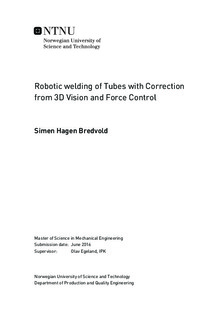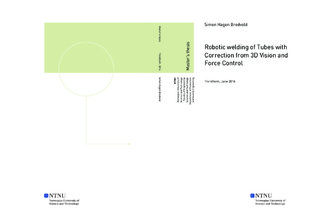| dc.description.abstract | The maritime industry are using steel tubes in both ship building and in the aquaculture industry. To keep labor cost down and to increase quality they want to expand their expertise in robotic welding to manufacture their products domestically. For this reason have the industry turned to NTNU and asked if their students could look into the handling and welding of tubes. This Master's thesis, on a general request from the maritime industry, have focused on how one can utilize a robot cell to handle and weld tubes with run-out together.
The approach to this thesis have been to use 3D computer vision and force control to correct for tube run-out by finding its error in position and orientation. To solve this the field of computer vision have been studied and presented, including various algorithms for data acquisition, filtering and object registration. For the later, Random sample consensus, Iterative Closest Point, SAmple Consensus Initial Alignment and a new method for aligning translation called Search Method are tested against the strict alignment precision required for welding. For safety of the robots, a Matlab application was developed to simulate the new poses generated by the alignment algorithms.
The solution was implemented in the robot cell at the Department of Production
and Quality Engineering NTNU utilizing a Kinect 3D-camera for data acquisition and four KUKA robots for handling and welding. The new poses were obtained and given to the robots using C++, Point Cloud Library and the establishment of a client-to-server connection in Java which made it possible to control the robots using a remote computer.
With a series of tests, each of the alignment algorithms were tested for precision and quality. The tests reviled that only the earch Method algorithm was good enough to align position for welding. The solution and its results led to the success of welding together tubes of different lengths and unknown run-out without re-programing the robots. | |

